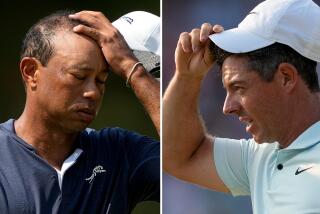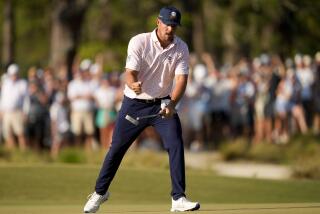Price Looks for Big One : He Missed Cut in ’94 Open, but He Hopes Things Will Be Different at Shinnecock
- Share via
SOUTHAMPTON, N.Y. — One of the newest residents of Jupiter, Fla., is discovering the lure of saltwater fishing. Nick Price knows it can be an expensive habit, so he has a plan.
“I haven’t bought any toys . . . not yet,” Price said. “I’m waiting for my next major.”
He has a chance to reel one in beginning Thursday at Shinnecock Hills, where the U.S. Open starts its four-day trek through tall grass and long odds. As usual, the rough will be allowed to grow only slightly shorter than the roof of the clubhouse and the winner may be the golfer least expected.
Last year, it was Ernie Els, who won his first major championship by outdueling Colin Montgomerie and Loren Roberts in an 18-hole playoff at Oakmont Country Club in Oakmont, Pa.
Price missed the cut. But he certainly did all right the rest of the year, winning the next two majors--the British Open and the PGA Championship.
Since then, Price has had keel problems. He became the No. 1-ranked golfer in the world, missed the cut at the Masters and at Houston, took three weeks off to move from Orlando while citing golf “burnout,” then returned to find out his game wasn’t in such bad shape after all.
Price shot a closing-round 66 in his comeback at the Colonial and finished 12th, then ended with a 65 at the Memorial, tying for 10th. Last week at the Kemper Open, Price finished in a tie for ninth.
“My game has improved a lot, but I don’t think it was really all that bad,” Price said. “I think it was the mental frustration of having my day-to-day life go into complete disarray [because of moving].
“Time off certainly put things into perspective for me and I’m scoring better as a result. I don’t know if I’m hitting the ball that much better, but I just feel like I’m trying harder than I was six weeks ago.”
Chances are Price and the rest of the 156-player U.S. Open field are going to have to try very hard at Shinnecock, the 6,944-yard Long Island layout where Raymond Floyd shot one-under-par 279 to win the 1986 U.S. Open. Lanny Wadkins and Chip Beck were runners-up.
Shinnecock is a links-style course that many believe favors those particularly adept at playing such layouts, like three-time British Open champion Nick Faldo.
Faldo has never played Shinnecock, but his teacher has come up with some interesting research that could help. Swing doctor David Leadbetter calculated the average wind speed at Shinnecock at 28 m.p.h.
“I heard it’s linksy and blows a gale,” Faldo said. “Sounds wonderful.”
Depending on which way it blows, it wouldn’t be too big a stretch to mention Price in the same sentence as Faldo as a potential U.S. Open winner, since Price won the British Open last year at wind-swept Turnberry Golf Links in Scotland.
“That’s something all of us who haven’t won one would dearly love to win--a U.S. Open,” Price said. “It’s a national championship, it’s a major championship and for me, it would be the third leg in going toward winning all four major titles, and that’s something I want to do very badly.
“I think the fact that it’s the U.S. Open is going to pique my interest a little further, which might be the tonic I need right now.”
Greg Norman’s game got a boost when he won the Memorial, which puts him among the top candidates to add the Open to his list of major titles that includes the British Open in 1986 and 1993.
Others expected to challenge include Els, Phil Mickelson, Vijay Singh, Lee Janzen, Davis Love III, Payne Stewart, Ben Crenshaw, Peter Jacobsen, Ian Woosnam, Montgomerie, Corey Pavin and Curtis Strange. It’s a list that doubtless will be amended many times in four days.
“The U.S. Open tests the patience of good chippers and putters because everyone misses a lot of greens,” Price said. “Is it more demanding physically or mentally? There’s no doubt in my mind it’s more demanding mentally because it just tests your patience.
“You can hit good shot after good shot and not get rewarded. You just have to sort of grin and bear it and try to chip and putt. On another course, you might be putting from 15 feet for a birdie, but [on a U.S. Open course] you are chipping from 40 feet out of the rough on the edge of the green.”
Of course, no matter how rough the rough, it’s worth tromping in the stuff if you win. The winner’s share is $350,000, and you can buy a nice fishing boat with that.
More to Read
Go beyond the scoreboard
Get the latest on L.A.'s teams in the daily Sports Report newsletter.
You may occasionally receive promotional content from the Los Angeles Times.










